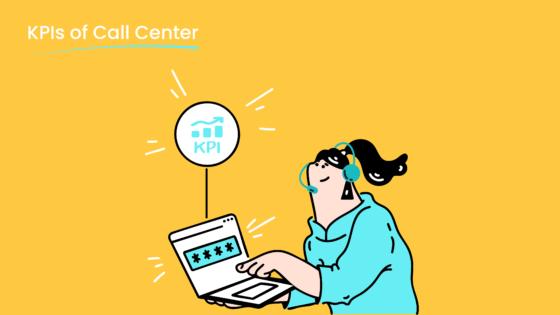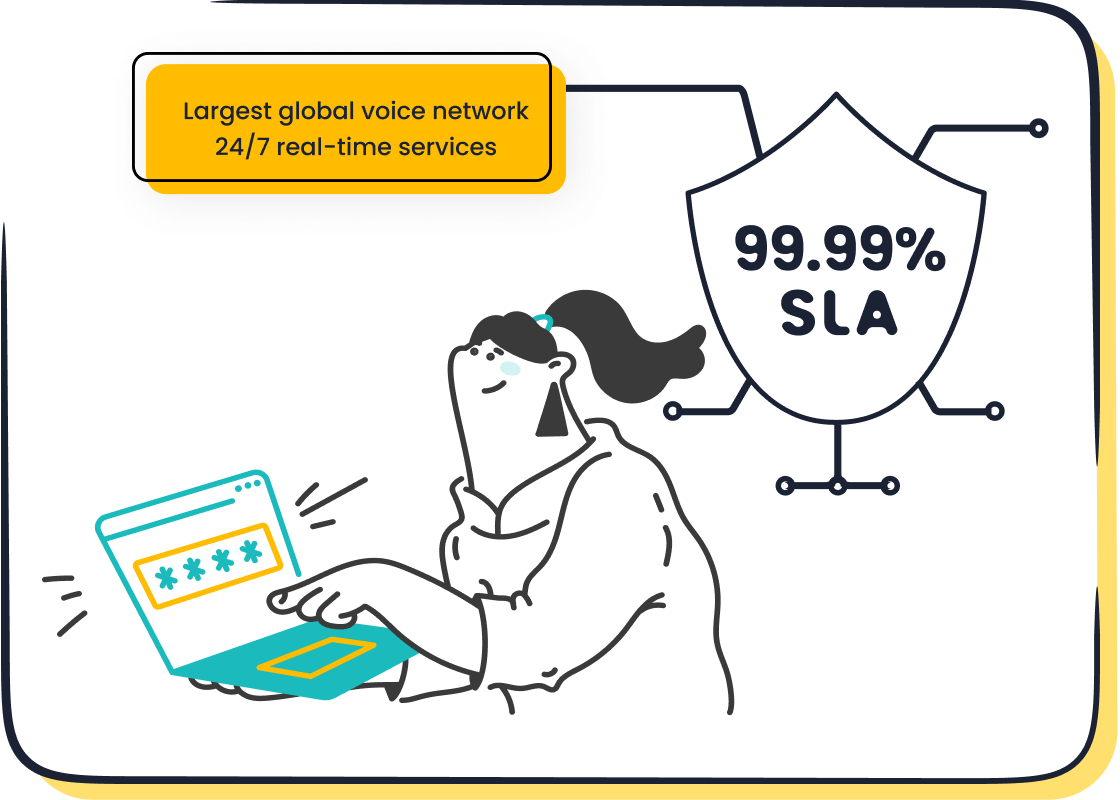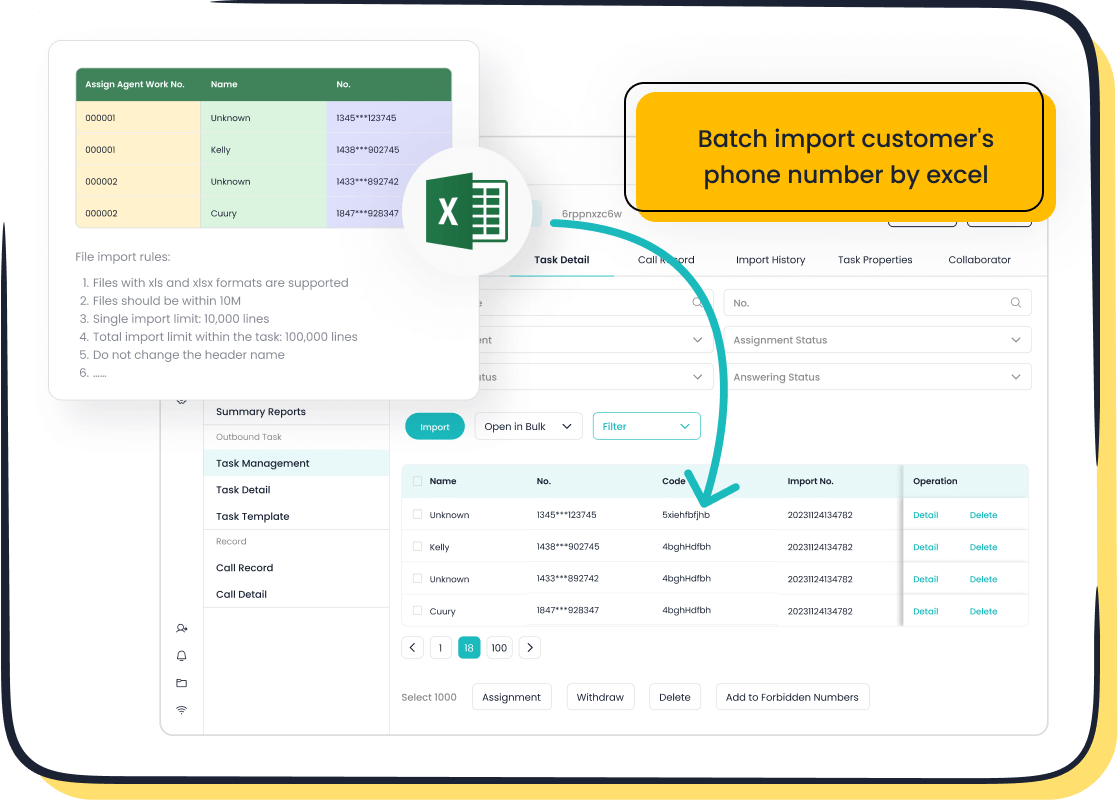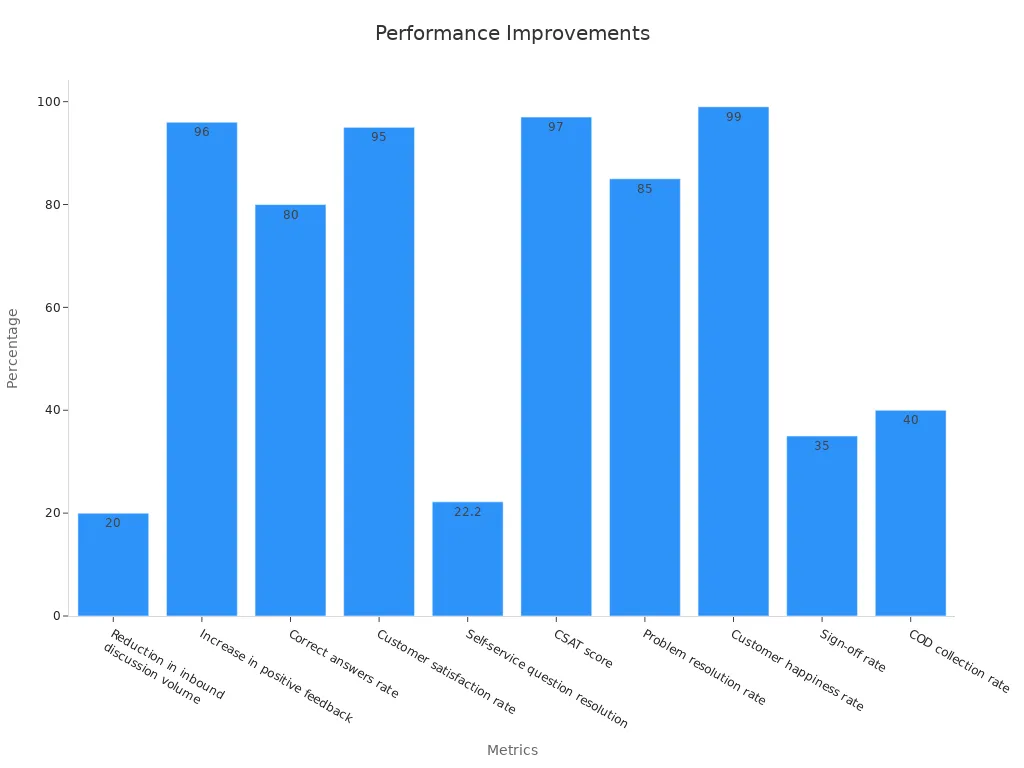How to Define Effective Benchmarks for Call Center Agents

Defining benchmarks is essential to improve call center agent productivity. Metrics such as Average Handle Time (AHT) and First Call Resolution (FCR) act as key performance indicators, guiding agents to work more efficiently and effectively. For example, achieving a higher FCR rate not only boosts customer satisfaction but also lowers operational costs. Companies that establish clear benchmarks often witness Customer Satisfaction (CSAT) scores rise from 75% to 85%, reflecting their dedication to delivering outstanding service. Sobot’s Voice/Call Center simplifies this process with advanced features like real-time monitoring and analytics, empowering agents to consistently meet or surpass performance targets.
Understanding Performance Benchmarks in Call Centers
What are performance benchmarks?
Performance benchmarks are measurable standards that help you evaluate the effectiveness of call center operations. These benchmarks act as reference points, enabling you to compare your team's performance against industry norms or internal goals. For example, metrics like Average Handle Time (AHT) and First Call Resolution (FCR) provide insights into how efficiently your agents resolve customer issues.
Different industries have varying expectations for these benchmarks. The table below highlights the average Wrap-Up Time across sectors:
| Industry | Average Wrap-Up Time (minutes) |
|---|---|
| Retail | 1 to 3 |
| Telecommunications | 2 to 5 |
| Banking and Financial | 3 to 6 |
| Technology | 1 to 4 |
| Healthcare | 4 to 8 |

By understanding these benchmarks, you can tailor your call center strategies to meet industry-specific standards. Tools like Sobot’s Voice/Call Center simplify this process by providing real-time monitoring and analytics, helping you track and improve performance metrics effortlessly.
Why are benchmarks critical for call center success?
Benchmarks are essential for driving success in call centers. They provide a clear framework for measuring progress, identifying areas for improvement, and ensuring alignment with business objectives. When you implement effective benchmarking, you gain actionable insights that enhance agent productivity and customer satisfaction.
Industry reports highlight several benefits of benchmarking:
- Benchmarks help you assess performance relative to industry standards, ensuring competitiveness.
- They offer actionable recommendations to improve operational efficiency.
- Comparative analysis enables you to identify gaps and implement targeted improvements.

For instance, Sobot’s Voice/Call Center empowers you to set and monitor benchmarks through features like intelligent IVR and AI-powered Voicebot. These tools streamline workflows, reduce Average Handle Time, and improve First Call Resolution rates, ultimately boosting customer satisfaction.
Common challenges in benchmarking for call centers
Benchmarking in call centers comes with its own set of challenges. High-volume contact centers often struggle to deliver seamless customer experiences due to fragmented communication channels. Additionally, many organizations lack strong leadership in customer experience (CX), which impacts consistency.
The table below outlines key statistical trends that highlight these challenges:
| Statistical Trend | Description |
|---|---|
| Customer Experience | High-volume contact centers prioritize customer experience, but many struggle to deliver seamless journeys. |
| CX Leadership | 46% of business leaders cite lack of CX leadership as a major barrier to consistency. |
| Cost-per-call | The average cost-per-call reached a five-year high in 2024, with 38.2% of callers abandoning after a minute. |
| FCR Rates | High FCR rates are impacted by organizational policies (49%), agent mistakes (38%), and customer miscommunication (13%). |

To overcome these challenges, you need robust tools that unify communication channels and provide actionable insights. Sobot’s Voice/Call Center addresses these issues with features like unified workspaces and seamless integration capabilities. These solutions help you reduce inefficiencies, improve customer satisfaction, and achieve consistent benchmarking results.
Identifying Key Metrics to Improve Call Center Agent Productivity

Efficiency metrics: Average Handle Time (AHT), First Call Resolution (FCR)
Efficiency metrics play a vital role in improving call center agent productivity. Average Handle Time (AHT) measures the total time agents spend on customer interactions, including talk time, hold time, and after-call work. By analyzing AHT, you can identify bottlenecks and streamline workflows. For example, reducing AHT often leads to lower operating costs and fewer customers at risk of defection. It also improves employee satisfaction by reducing stress during high call volumes.
| Impact Area | Description |
|---|---|
| Reduces operating costs | Lower costs associated with handling customer interactions. |
| Improves customer satisfaction | Higher satisfaction levels among customers. |
| Increases opportunities to sell | More chances to upsell or cross-sell to satisfied customers. |
First Call Resolution (FCR) is another critical metric. It measures the percentage of customer issues resolved during the first interaction. Higher FCR rates indicate better service quality and fewer repeat calls, which directly enhance customer satisfaction. Sobot’s Voice/Call Center supports these metrics with features like intelligent IVR and AI-powered Voicebot, enabling agents to resolve issues faster and more effectively.
Quality metrics: Customer Satisfaction Score (CSAT), Net Promoter Score (NPS)
Quality metrics focus on the customer experience. Customer Satisfaction Score (CSAT) evaluates how satisfied customers feel after interacting with your call center. A higher CSAT score reflects better service and increased loyalty. Measuring CSAT helps you pinpoint areas for improvement, ensuring a consistent performance improvement plan.
Net Promoter Score (NPS) measures long-term customer loyalty by assessing the likelihood of customers recommending your brand. It categorizes customers into Promoters, Passives, and Detractors. Promoters are more likely to return and spend more, making NPS a valuable tool for tracking customer satisfaction trends. Sobot’s analytics tools provide actionable insights into these metrics, helping you refine your strategies.
Balancing quantitative and qualitative metrics for comprehensive benchmarking
A balanced approach to benchmarking combines quantitative and qualitative metrics. Quantitative metrics, like AHT and FCR, provide numerical data to track efficiency. Qualitative metrics, such as customer feedback, reveal deeper insights into preferences and satisfaction. Together, they create a comprehensive performance improvement plan.
For example, analyzing both AHT and customer feedback can help you understand why certain calls take longer. Sobot’s unified workspace integrates these metrics, offering a holistic view of agent performance. This approach ensures you address both operational efficiency and customer satisfaction, driving sustainable improvements.
Steps to Set Effective Performance Goals for Call Center Agents
Analyze current performance data and trends
Analyzing current performance data is the first step in setting effective performance goals. Start by reviewing key metrics such as Average Handle Time (AHT), First Call Resolution (FCR), and Customer Satisfaction (CSAT). These metrics provide a clear picture of your call center's strengths and areas for improvement. For example, if your CSAT score is below industry standards, you can focus on improving customer interactions to boost satisfaction.
A detailed analysis of trends helps you identify patterns and set realistic targets. The table below highlights examples of performance data and corresponding goals:
| Metric | Goal Description |
|---|---|
| Customer Satisfaction (CSAT) | Improve CSAT by 5% this month. |
| Call Transfer Rates | Reduce call transfers by 15% this year. |
| Response Time | Improve response time by 20% this quarter. |
| Training Participation | Attend at least three training courses every quarter. |

By using tools like Sobot’s Voice/Call Center, you can track these metrics in real time. Features such as call tracking and analytics provide actionable insights, enabling you to adjust strategies and achieve your performance goals more effectively.
Align benchmarks with business objectives and customer expectations
Aligning benchmarks with business objectives ensures that your call center contributes to the overall success of your organization. For example, if your company prioritizes customer retention, focus on metrics like Net Promoter Score (NPS) and First Call Resolution (FCR). These metrics directly impact customer loyalty and satisfaction.
The table below outlines the benefits of aligning benchmarks with business goals and customer expectations:
| Benefit of Aligning Benchmarks | Description |
|---|---|
| Establishes clear standards | Setting quantifiable targets aligned with business objectives and customer expectations helps identify improvement opportunities. |
| Optimizes resource allocation | Data-driven benchmarks support strategic planning and staffing, ensuring efficiency during peak periods. |
| Adapts to changing industry standards | Benchmarks help contact centers align with evolving customer expectations and adopt best practices. |
Sobot’s Voice/Call Center simplifies this process with features like intelligent IVR and AI-powered Voicebot. These tools help you meet customer expectations by reducing response times and improving service quality. Regularly reviewing benchmarks ensures they remain relevant to both your business goals and the evolving needs of your customers.
Set SMART (Specific, Measurable, Achievable, Relevant, Time-bound) goals
Setting SMART goals provides a structured approach to improving call center performance. Each goal should be:
- Specific: Clearly define what you want to achieve. For example, "Reduce Average Handle Time by 10% in the next quarter."
- Measurable: Use metrics to track progress. Tools like Sobot’s analytics dashboard make it easy to monitor key performance indicators.
- Achievable: Ensure the goal is realistic based on current performance data. For instance, improving FCR by 5% may be more feasible than aiming for 20%.
- Relevant: Align the goal with your business objectives. If customer satisfaction is a priority, focus on improving CSAT scores.
- Time-bound: Set a deadline to create urgency and accountability. For example, "Achieve a 90% CSAT score by the end of the year."
Engaging agents in the goal-setting process can also improve outcomes. When agents feel involved, they are more likely to stay motivated and committed to achieving the goals. Sobot’s unified workspace fosters collaboration by providing agents with the tools and data they need to succeed.
Involve agents in the benchmarking process for better engagement.
Involving your agents in the benchmarking process can significantly enhance their engagement and performance. When agents actively participate in setting and understanding benchmarks, they feel more valued and motivated to achieve their goals. This collaborative approach fosters a sense of ownership and accountability, which directly impacts productivity and customer satisfaction.
Start by sharing performance data with your team. For example, if your call center's First Call Resolution (FCR) rate is 70%, discuss this metric with your agents. Ask for their insights on why certain calls require follow-ups and brainstorm solutions together. This open dialogue not only builds trust but also helps you identify practical ways to improve performance.
You can also involve agents by encouraging them to set personal goals aligned with the overall benchmarks. For instance, an agent might aim to reduce their Average Handle Time (AHT) by 10% over the next month. Tools like Sobot’s Voice/Call Center make this process easier by providing real-time analytics and personalized performance dashboards. These features allow agents to track their progress and adjust their strategies as needed.
Training sessions are another effective way to engage agents in the benchmarking process. Use these sessions to explain the importance of each benchmark and how it ties into the company's objectives. For example, you could demonstrate how improving Net Promoter Score (NPS) can lead to higher customer retention rates. Sobot’s unified workspace simplifies this by integrating training materials and performance data, making it easier for agents to connect their efforts to tangible outcomes.
Recognition and rewards also play a crucial role in keeping agents engaged. Celebrate milestones, such as achieving a 90% Customer Satisfaction Score (CSAT) or reducing call transfer rates. Publicly acknowledging these achievements boosts morale and encourages other agents to strive for similar success.
Finally, create a feedback loop where agents can share their experiences and suggestions for refining benchmarks. For example, an agent might suggest adjusting the Wrap-Up Time target based on the complexity of certain customer issues. Sobot’s Voice/Call Center supports this by offering features like call tracking and analytics, which provide actionable insights for both agents and managers.
By involving your agents in the benchmarking process, you create a collaborative environment where everyone works toward shared goals. This not only improves individual performance but also enhances the overall efficiency of your call center.
Leveraging Sobot's Voice/Call Center for Benchmarking and Monitoring
Features of Sobot's Voice/Call Center for performance tracking
Sobot's Voice/Call Center offers advanced features that simplify performance tracking for call centers. Intelligent IVR allows you to customize greetings and route calls efficiently. The unified workspace provides agents with a centralized platform to manage calls and access customer information. This feature reduces the time spent switching between systems, improving productivity.

The platform also includes call tracking and analytics tools. These tools help you monitor key metrics like Average Handle Time (AHT) and First Call Resolution (FCR). For example, tracking AHT enables you to identify bottlenecks and streamline workflows. Sobot's AI-powered Voicebot enhances performance by handling repetitive tasks, freeing agents to focus on complex issues.
Sobot’s Voice/Call Center supports global telephony contacts, ensuring seamless communication across different regions. Its 99.99% system uptime guarantees reliability, even during peak periods. These features make it easier for you to set benchmarks and monitor progress effectively.
Real-time monitoring and analytics for continuous improvement
Real-time monitoring is essential for maintaining high performance in call centers. Sobot's Voice/Call Center provides live analytics that allow you to track agent activities and customer interactions as they happen. This feature helps you identify issues immediately and take corrective action.
For instance, if an agent struggles with a specific type of query, you can use real-time data to provide targeted training. This approach improves agent skills and enhances customer satisfaction. The platform also offers detailed reports on metrics like Customer Satisfaction Score (CSAT) and Net Promoter Score (NPS). These insights enable you to refine your strategies and achieve continuous improvement.
Sobot’s analytics tools integrate seamlessly with your existing systems, ensuring you have access to comprehensive data. By leveraging these tools, you can optimize workflows, reduce Average Handle Time, and improve First Call Resolution rates.
Integration capabilities for seamless data management
Effective benchmarking requires seamless data management. Sobot's Voice/Call Center integrates easily with CRM systems and other technology platforms. This integration ensures that your agents have access to complete customer histories, enabling them to provide personalized service.
The platform supports global number availability, allowing you to manage calls across different regions without complications. Its encrypted data transfer ensures security, protecting sensitive customer information. For example, integrating Sobot’s Voice/Call Center with your CRM system can help you track customer interactions and identify trends.
Sobot’s integration capabilities also simplify training processes. You can use the platform to deliver training materials directly to agents, ensuring they have the resources needed to meet benchmarks. This feature enhances engagement and helps agents improve their performance.
By unifying data across systems, Sobot’s Voice/Call Center enables you to set realistic benchmarks and monitor progress efficiently. This approach ensures that your call center remains competitive and delivers exceptional service.
Tools and Technologies to Enhance Benchmarking in Call Centers

Call center software for tracking and reporting metrics
Call center software plays a vital role in tracking and reporting performance metrics. These tools help you monitor key indicators like Average Handle Time (AHT) and First Call Resolution (FCR). By using such software, you can identify trends, address inefficiencies, and improve overall productivity. For example, Sobot’s Voice/Call Center offers features like call tracking and real-time analytics. These capabilities allow you to measure agent performance and customer satisfaction effectively.
The software also simplifies reporting by consolidating data into a unified workspace. This feature reduces the time spent switching between systems, enabling agents to focus on delivering excellent service. With tools like Sobot’s intelligent IVR and AI-powered Voicebot, you can automate repetitive tasks and allocate resources more efficiently. These technologies not only enhance operational efficiency but also contribute to achieving higher customer satisfaction scores.
Analytics tools for actionable insights
Advanced analytics tools provide actionable insights that help you refine your call center strategies. These tools analyze large volumes of data to uncover patterns and trends, enabling you to make informed decisions. For instance, platforms like ThoughtSpot empower users with enterprise AI for real-time data exploration. Similarly, NICE Ltd. offers solutions that enhance analytics capabilities, improving both efficiency and customer satisfaction.
| Tool Name | Description |
|---|---|
| ThoughtSpot | Empowers users with enterprise AI for real-time insights. |
| NICE Ltd. | Enhances analytics in contact centers for better results. |
Sobot’s Voice/Call Center integrates analytics tools seamlessly, offering detailed reports on metrics like Net Promoter Score (NPS) and Customer Satisfaction Score (CSAT). These insights help you identify areas for improvement and implement targeted strategies. By leveraging analytics, you can optimize workflows, reduce costs, and enhance the overall customer experience.
Reporting dashboards for performance visualization
Reporting dashboards transform complex data into easy-to-understand visualizations. These tools allow you to monitor key performance indicators (KPIs) and identify trends quickly. AI-powered dashboards, for example, enable you to analyze historical data alongside real-time metrics. This capability helps you adapt strategies effectively and improve decision-making.
- Dashboards provide intuitive visualizations, making it easier to spot trends and anomalies.
- Real-time monitoring allows you to take corrective actions promptly.
- Integrating customer interaction data enhances your understanding of customer needs.

Sobot’s Voice/Call Center includes customizable dashboards that consolidate data from various sources. These dashboards offer instant access to metrics, fostering a culture of responsiveness and efficiency. By using these tools, you can prioritize changes that enhance customer satisfaction and drive continuous improvement.
Continuous Improvement Through Feedback and Benchmark Adjustments
The role of regular performance reviews in benchmarking
Regular performance reviews are essential for driving continuous improvement in your call center. These reviews provide a structured way to assess key metrics and identify areas for growth. Metrics like First Call Resolution (FCR) and Customer Satisfaction Score (CSAT) offer valuable insights into efficiency and service quality. For example, a high FCR rate shows that agents resolve issues effectively during the first interaction, while CSAT reflects how satisfied customers feel after their calls. Net Promoter Score (NPS) adds another layer by measuring customer loyalty and their likelihood to recommend your services.
By conducting regular reviews, you can track these metrics over time and adjust strategies to meet evolving goals. Sobot’s Voice/Call Center simplifies this process with real-time analytics and customizable dashboards. These tools allow you to monitor performance trends and make data-driven decisions, ensuring your team consistently delivers exceptional service.
Creating a feedback loop with agents for ongoing improvement
A structured feedback loop with your agents fosters a culture of accountability and growth. Sharing clear evaluation metrics helps agents understand expectations and align their efforts with organizational goals. Regular evaluations highlight strengths and weaknesses, empowering agents to improve their skills and enhance customer interactions. For instance, an agent struggling with long Average Handle Time (AHT) can receive targeted coaching to streamline their workflow.
Feedback also boosts morale and engagement. When agents feel heard, they are more likely to contribute ideas for improvement. Sobot’s unified workspace supports this by providing agents with access to performance data and training resources. This transparency encourages collaboration and ensures everyone works toward shared benchmarks. Recognizing achievements, such as improved FCR rates, further motivates agents and reinforces a commitment to excellence.
Adjusting benchmarks to reflect evolving business needs
Benchmarks should evolve alongside your business to remain relevant and effective. As customer expectations change, you must adapt your goals to maintain high performance. For example, if your call center experiences an increase in complex queries, you might adjust Wrap-Up Time targets to account for the additional effort required.
Using tools like Sobot’s Voice/Call Center, you can analyze trends and refine benchmarks in real time. Features like intelligent IVR and AI-powered Voicebot provide insights into customer behavior, helping you set realistic and achievable goals. Regularly reviewing and updating benchmarks ensures they align with both your business objectives and customer needs, driving continuous improvement across your operations.
Setting and monitoring effective benchmarks is essential for improving call center performance. Benchmarks like First Call Resolution (FCR) and Customer Satisfaction Score (CSAT) help you identify areas for improvement and align with industry standards.
- Why it matters:
- Benchmarking drives operational efficiency and enhances customer satisfaction.
- Studies show it helps call centers adopt best practices and improve service quality.
Sobot’s Voice/Call Center simplifies this process with tools like real-time analytics and intelligent IVR. These features have led to a 97% CSAT score and a 20% reduction in inbound discussion volume, as shown below:

Prioritize continuous improvement by involving agents in goal-setting and feedback loops. This approach fosters engagement and ensures sustained success.
FAQ
What are call center industry benchmarks, and why are they important?
Call center industry benchmarks are standards used to measure performance against industry norms. They help you evaluate agent performance enhancement efforts and identify areas for improvement. For example, achieving a First Call Resolution rate of 80% or higher is a common benchmark that reflects excellent service quality.
How can training programs improve agent performance?
Training programs equip agents with the skills needed to handle calls efficiently. Regular coaching sessions focus on specific challenges, such as reducing Average Handle Time. Sobot’s Voice/Call Center supports training by providing real-time analytics, helping you track progress and refine strategies for agent performance enhancement.
What tools help in establishing quantifiable targets for agents?
Tools like Sobot’s Voice/Call Center simplify establishing quantifiable targets. Features such as call tracking and analytics allow you to monitor key performance indicators like Customer Satisfaction Score. These insights help you set realistic goals, ensuring agents align with business objectives and deliver exceptional service.
How do you identify areas for improvement in a call center?
You can identify areas for improvement by analyzing metrics like Average Handle Time and Net Promoter Score. Sobot’s Voice/Call Center provides actionable insights through real-time monitoring and reporting dashboards. These tools highlight inefficiencies, enabling you to implement targeted solutions for agent performance enhancement.
Why is regular coaching important for call center agents?
Regular coaching sessions help agents refine their skills and adapt to evolving customer needs. For instance, coaching can address challenges like high call transfer rates. Sobot’s unified workspace supports this process by offering performance data and training resources, ensuring continuous improvement.
See Also
Top Strategies for Effective Call Center Quality Management
Enhancing Call Center Efficiency Through Effective Monitoring
Effective Strategies for Managing Live Chat Representatives
Essential Software Solutions for Call Center Quality Assurance
